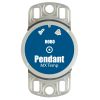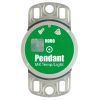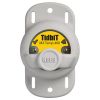HOBO TidbiT v2 Temperature Logger
Features
- Onset's smallest temperature data logger (3x4 cm)
- Waterproof to 300 meters (1,000 feet)
- Data readout in less than 30 seconds via fast Optic USB interface
- Expedited repair and warranty service
- Lifetime technical support
- More
Overview
The Onset HOBO TidbiT v2 Temperature Logger measures temperatures over a wide temperature range in outdoor and underwater environments. The TidbiT v2 provides 12-bit resolution and has ±0.2 °C accuracy. It is designed for outdoor and underwater environments and is waterproof to 300m (1000 ft). An optical USB interface allows users to offload data in seconds.
*Please note: A solar radiation shield is required to obtain accurate air temperature measurements in sunlight (RS1 Solar Radiation Shield, assembly required; or M-RSA pre-assembled Solar Radiation Shield).
Temperature Sensor
Operation range:* -20° to 70°C (-4° to 158°F) in air; maximum sustained temperature of 30°C (86°F) in water*
Accuracy: ±0.21°C from 0° to 50°C (±0.38°F from 32° to 122°F)
Resolution: 0.02°C at 25°C (0.04°F at 77°F)
Response time: 5 minutes in water; 12 minutes in air moving 2 m/sec; 20 minutes in air moving 1 m/sec (typical to 90%)
Stability (drift): 0.1°C (0.18°F) per year
Logger
Real-time clock: ± 1 minute per month 0° to 50°C (32° to 122°F)
Battery: 3 Volt lithium, non-replaceable
Battery life (typical use): 5 years with 1 minute or greater logging interval
Memory (non-volatile): 64K bytes memory (approx. 42,000 12-bit temperature measurements)
Weight: 19.6 g (0.69 oz)
Dimensions: 3.0 × 4.1 × 1.7 cm (1.2 × 1.6 × 0.68 in.); mounting bail 4.6 mm (3/16 in.) diameter hole
Wetted materials: Epoxy case
Waterproof: To 305 m (1000 ft.)
Logging interval: Fixed-rate or multiple logging intervals, with up to 8 user-defined logging intervals and durations; logging intervals from 1 second to 18 hours. Refer to HOBOware software manual.
Launch modes: Immediate start, delayed start
Offload modes: Offload while logging; stop and offload
Battery indication: Battery level can be viewed in status screen and optionally logged in datafile. Low battery indication in datafile.
Environmental Rating: IP68
NIST certificate: Available for additional charge
* To guarantee accuracy, the TidbiT v2 Temp must not be used in condensing environments and water temperatures higher than 30C (86F) for more than eight cumulative weeks over the life of the logger. Frequent or prolonged exposure will lead to measurement drift and eventual failure.
In The News
Wildfire Prevention in the Sierra Nevada Region with the Yuba Watershed Institute
Though recent wildfires have sparked new conversations about wildfire management and response, groups like the Yuba Watershed Institute have been monitoring the forests and water resources of the Sierra Nevada region for decades, managing approximately 5,000 acres of land with the Bureau of Land Management (BLM) and about 7,000 acres in private land partnerships. The goal of the Institute is to work with local communities and land agencies to improve watershed and forestry management through informed practices and public outreach. The goals of the Yuba Watershed Institute are three-fold: Improve the ability of fire suppression agencies like the California Department of Forestry and Fire Protection ( CAL FIRE ) and the US Forest Service.
Read MoreWave Sensors Integration with NexSens Buoys: A Cutting-Edge Solution for Wave Measurment
Real-time wave data supports accurate weather prediction, safe and efficient maritime operations, and provides valuable safety and operating condition information for recreation and commercial fishing. Understanding wave dynamics also helps with the design of protective coastal structures like seawalls, breakwaters, and jetties. It also supports better prediction of their impact on sediment transport and coastal geomorphology. Wave data is a key factor in qualifying and designing offshore wind farms and harnessing kinetic energy for electrical generation. It helps with the understanding of ocean-atmosphere interactions and contributes to studies of sea-level rise and climate change impacts.
Read MoreSpring 2025 Environmental Monitor Available Now
In the Spring 2025 edition of the Environmental Monitor, we highlight partnerships across the world and the importance of collaboration between government agencies, universities, environmental groups, local communities, and other stakeholders. From great white shark research in Cape Cod to monitoring fisheries in Lake Erie, this latest edition underscores partnerships that connect stakeholders in a watershed through environmental data. With an emphasis on data sharing, a combination of real-time and discrete sampling keeps the public and partners informed of environmental conditions. Our writers also sought out science professionals dedicated to working with peers within and outside of the environmental sector.
Read More


















